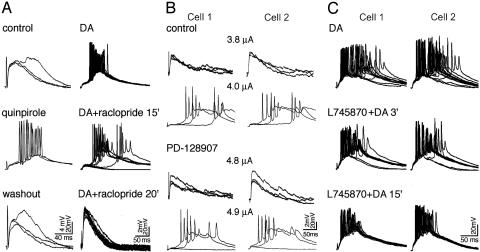Fig. 4.
Distinctive effects of D2 family receptors on DA-promoted bursting. (A) D2 receptor agonist reproduced and D2 antagonist blocked DA bursts. (Left) Bursting induced by applying DA (data not shown) was then eliminated by washout of DA (Top). Quinpirole (10 μM) reproduced bursting within 3 min (Middle); the bursts disappeared after washout of quinpirole for 5 min (Bottom). (Right) Bursting responses induced by DA (25 μM, Top). Raclopride (10 μM) attenuated the bursts within 15 min, presenting no bursts in most sweeps (Middle), and completely blocked the bursts by 20 min (Bottom). (B) D3 receptor agonism increased the threshold for DA-promoted bursting. In control, bursting responses were initiated in both cells with a stimulating strength of 4.0 μA (upper two rows). After applying PD-128907 (100 nM), a 4.9-μA stimulus was required to trigger the bursting (bottom two rows). (C) D4 receptor antagonism could not block DA-promoted bursts. DA promoted bursts in all 12 sweeps (Top). Note that in some sweeps the bursts occurred after long latencies. Despite the application of L745870 (1μM) the bursting responses gradually became stronger indicated by gradually shorter latencies (Middle and Bottom). Note the similarity in pattern and time scale of bursting activity exhibited by the simultaneously recorded pairs of cells in B and C.

